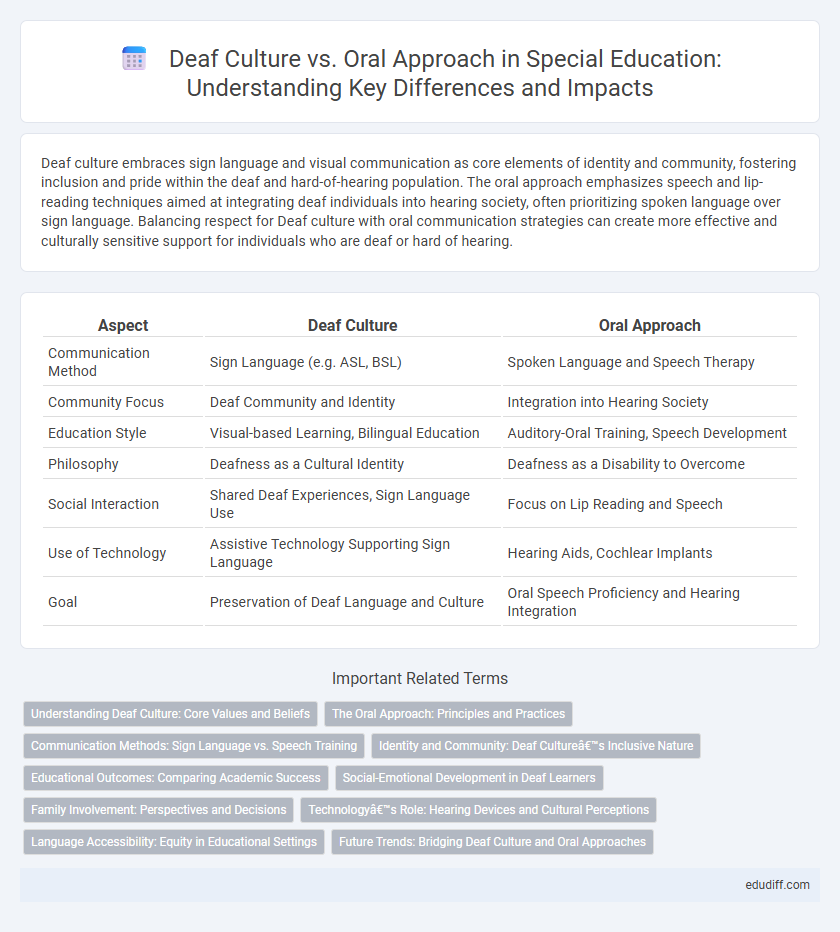Deaf culture embraces sign language and visual communication as core elements of identity and community, fostering inclusion and pride within the deaf and hard-of-hearing population. The oral approach emphasizes speech and lip-reading techniques aimed at integrating deaf individuals into hearing society, often prioritizing spoken language over sign language. Balancing respect for Deaf culture with oral communication strategies can create more effective and culturally sensitive support for individuals who are deaf or hard of hearing.
Table of Comparison
| Aspect | Deaf Culture | Oral Approach |
|---|---|---|
| Communication Method | Sign Language (e.g. ASL, BSL) | Spoken Language and Speech Therapy |
| Community Focus | Deaf Community and Identity | Integration into Hearing Society |
| Education Style | Visual-based Learning, Bilingual Education | Auditory-Oral Training, Speech Development |
| Philosophy | Deafness as a Cultural Identity | Deafness as a Disability to Overcome |
| Social Interaction | Shared Deaf Experiences, Sign Language Use | Focus on Lip Reading and Speech |
| Use of Technology | Assistive Technology Supporting Sign Language | Hearing Aids, Cochlear Implants |
| Goal | Preservation of Deaf Language and Culture | Oral Speech Proficiency and Hearing Integration |
Understanding Deaf Culture: Core Values and Beliefs
Deaf culture centers around a shared language, primarily American Sign Language (ASL), and a strong sense of community identity, emphasizing visual communication and social connections within the Deaf community. Core values include Deaf pride, linguistic accessibility, and the rejection of the notion that deafness is a disability needing correction. Understanding these beliefs highlights the contrast with the oral approach, which focuses on speech and lip-reading, often overlooking cultural identity and the significance of sign language in fostering Deaf empowerment.
The Oral Approach: Principles and Practices
The Oral Approach emphasizes spoken language development through lip reading, speech training, and auditory skill enhancement, prioritizing integration into the hearing community. Techniques center on maximizing residual hearing using hearing aids and cochlear implants, fostering verbal communication without reliance on sign language. This approach advocates early intervention and consistent practice to improve speech intelligibility and listening skills in deaf and hard-of-hearing individuals.
Communication Methods: Sign Language vs. Speech Training
Deaf culture prioritizes sign language as the primary communication method, emphasizing visual-spatial interaction through American Sign Language (ASL) or other regional sign languages that foster community identity and cognitive development. In contrast, the oral approach focuses on speech training and lip-reading techniques to integrate deaf individuals into hearing society by enhancing spoken language proficiency and auditory skills. Each method offers distinct benefits, with sign language promoting natural linguistic expression in Deaf culture and speech training facilitating verbal communication within predominantly hearing environments.
Identity and Community: Deaf Culture’s Inclusive Nature
Deaf Culture fosters a strong sense of identity through the use of sign language and shared experiences, emphasizing community inclusion and cultural pride. The Oral Approach, focused on speech and lip-reading, often isolates individuals by prioritizing assimilation into hearing norms rather than cultural belonging. Embracing Deaf Culture promotes social connection and empowerment within the Deaf community, reinforcing collective identity and resilience.
Educational Outcomes: Comparing Academic Success
Deaf culture-centered education emphasizes sign language and visual learning, fostering stronger identity and community connections, which often correlates with higher engagement and academic achievement among Deaf students. In contrast, the Oral Approach prioritizes spoken language and lip-reading skills, aiming to integrate Deaf students into hearing environments but sometimes leads to lower academic outcomes due to communication barriers. Studies reveal that Deaf culture-based programs typically yield better literacy rates and overall academic success compared to strictly oral methodologies.
Social-Emotional Development in Deaf Learners
Deaf culture emphasizes the use of sign language as a vital tool for social-emotional development, fostering a strong sense of community and identity among deaf learners. The oral approach, which prioritizes speech and lip-reading, may limit social interaction and emotional expression, potentially leading to isolation or reduced self-esteem. Research indicates that integrating sign language supports emotional well-being by enhancing communication access and promoting social inclusion in deaf educational settings.
Family Involvement: Perspectives and Decisions
Family involvement plays a crucial role in shaping decisions within Deaf culture and the oral approach, influencing communication methods and identity development. Deaf culture often emphasizes familial support through sign language and shared Deaf experiences, fostering a strong communal bond. In contrast, families adopting the oral approach prioritize speech and auditory training, reflecting differing perspectives on integration and educational strategies.
Technology’s Role: Hearing Devices and Cultural Perceptions
Hearing devices such as cochlear implants and advanced hearing aids revolutionize communication options within Deaf culture, enhancing auditory access while sparking diverse cultural perceptions. Technology serves as a bridge in the oral approach by facilitating speech development and auditory integration but sometimes raises concerns about cultural identity preservation. The evolving dialogue emphasizes balancing technological benefits with respect for Deaf cultural values and community cohesion.
Language Accessibility: Equity in Educational Settings
Deaf culture prioritizes American Sign Language (ASL) as the primary mode of communication, ensuring language accessibility and cultural identity within educational settings. The oral approach emphasizes speech and lip-reading, often limiting access for Deaf students who rely on visual language. Equitable education requires integrating ASL and Deaf cultural values to promote inclusive learning environments that respect diverse communication needs.
Future Trends: Bridging Deaf Culture and Oral Approaches
Future trends in Deaf culture and oral approaches emphasize the integration of sign language and spoken language technologies to create inclusive communication environments. Advancements in assistive technologies, such as real-time captioning and AI-driven sign language recognition, facilitate greater accessibility and empowerment for Deaf individuals. Collaborative educational models are emerging, combining Deaf cultural identity with oral communication skills to promote bilingual fluency and social inclusion.
Deaf Culture vs Oral Approach Infographic

 edudiff.com
edudiff.com